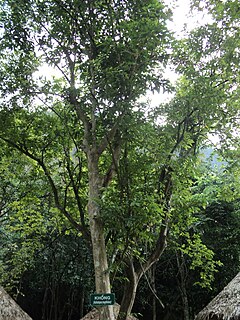
Cryptocoryne is a genus of aquatic plants from the family Araceae. The genus is naturally distributed in tropical regions of India, Southeast Asia and New Guinea.

Gnetum is a genus of gymnosperms, the sole genus in the family Gnetaceae and order Gnetales. They are tropical evergreen trees, shrubs and lianas. Unlike other gymnosperms, they possess vessel elements in the xylem. Some species have been proposed to have been the first plants to be insect-pollinated as their fossils occur in association with extinct pollinating scorpionflies. Molecular phylogenies based on nuclear and plastid sequences from most of the species indicate hybridization among some of the Southeast Asian species. Fossil-calibrated molecular-clocks suggest that the Gnetum lineages now found in Africa, South America and Southeast Asia are the result of ancient long-distance dispersal across seawater.

Antidesma is a genus of tropical plant in the Phyllanthaceae formally described by Linnaeus in 1753. It is native to tropical Africa, S + E + SE Asia, Australia, and various oceanic islands. The greatest diversity occurs in Southeast Asia.

Mallotus is a genus of the spurge family Euphorbiaceae first described as a genus in 1790. Two species are found in tropical Africa and Madagascar. All the other species are found in East Asia, the Indian Subcontinent, Southeast Asia, eastern Australia, and certain islands of the western Pacific.

Acanthophippium is a genus of orchid with twelve species. The name of this genus is derived from the Greek words acanthos ("spiny") and ephippion ("saddle"), referring to the saddle-like labellum of the plants.
Trigonostemon is a plant genus of the family Euphorbiaceae and the sole member of its tribe (Trigonostemoneae). It was first described as a genus in 1826. It is native to Southeast Asia, southern China, the Indian Subcontinent, Queensland, and a few islands in the western Pacific.

Agrostistachys is a plant genus of the family Euphorbiaceae first described as a genus in 1850. It is native to Southeast Asia, New Guinea, India, and Sri Lanka.
- Agrostistachys borneensisBecc. - India, Sri Lanka, Thailand, Vietnam, Malaysia, Borneo, Philippines, Sumatra, New Guinea
- Agrostistachys gaudichaudiiMüll.Arg. - Thailand, Peninsular Malaysia
- Agrostistachys hookeri(Thwaites) Benth. & Hook.f. - Sri Lanka
- Agrostistachys indicaDalzell - India, Sri Lanka, Thailand, Vietnam, Myanmar, Laos, Cambodia, Malaysia, Borneo, Philippines, New Guinea
- Agrostistachys sessilifolia(Kurz) Pax & K.Hoffm. - Peninsular Malaysia, Borneo, Sumatra
- Agrostistachys staminodiataSevilla - Sumatra

Koilodepas is a genus of plant of the family Euphorbiaceae first described as a genus in 1856. It is native to Southeast Asia, India, Hainan, and New Guinea.
Endospermum is a genus of plants, under the family Euphorbiaceae and the monotypic subtribe Endosperminae first described as a genus in 1861 It is native to E + S + SE Asia, Papuasia, Queensland, and certain islands of the W Pacific.

Dimorphocalyx is a genus of plants under the family Euphorbiaceae first described as a genus in 1861. It is native to Southeast Asia, Hainan, India, Sri Lanka, New Guinea, and Queensland.
Pimelodendron is a plant genus in the family Euphorbiaceae first described as a genus in 1855. It is native to insular Southeast Asia, Thailand, Papuasia, and Queensland.

Aporosa is a genus of flowering plant belonging to the family Phyllanthaceae first described as a genus in 1825. It is native to China, the Indian Subcontinent, Southeast Asia, Papuasia, and Queensland.

Cleistanthus is a plant genus of the family Phyllanthaceae, tribe Bridelieae, first described as a genus in 1848. It is widespread in much of the Old World Tropics in Asia, Africa, Australia, and various oceanic islands. Cleistanthus collinus is known for being toxic and may be the agent of homicides or suicides.

Breynia is a plant genus in the family Phyllanthaceae, first described in 1776. It is native to Southeast Asia, China, the Indian Subcontinent, Papuasia, Australia, and the island of Réunion.

Drypetes is a plant genus of the family Putranjivaceae, in the order Malpighiales.

Daphniphyllum is the sole genus in the flowering plant family Daphniphyllaceae and was described as a genus in 1826. The genus includes evergreen shrubs and trees mainly native to east and southeast Asia, but also found in the Indian Subcontinent and New Guinea.

Pothos is a genus of flowering plants in the Araceae family. It is native to China, the Indian Subcontinent, Australia, New Guinea, Southeast Asia, and various islands of the Pacific and Indian Oceans.

Scindapsus is a genus of flowering plants in the family Araceae. It is native to Southeast Asia, New Guinea, Queensland, and a few western Pacific islands. The species Scindapsus pictus is common in cultivation.

Globba is a genus of plants in the ginger family. It contains about 100 species, native to China, the Indian Subcontinent, Southeast Asia, New Guinea, the Bismarck Archipelago and Queensland.
Ptychopyxis javanica is a plant species in the Euphorbiaceae. It is native to southern Thailand, Vietnam, Peninsular Malaysia, Borneo, Sumatra, and Java.
















